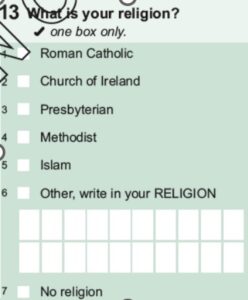by Gina A. Zurlo, Ph.D. – Co-Director – Center for the Study of Global Christianity
This post is part of The Occasional’s “Numbers and Trends” series, dedicated to sharing work, analysis, and perspectives from our friends and partners at the Center for the Study of Global Christianity based at Gordon-Conwell Theological Seminary.
As a quantitative scholar of World Christianity, by far the #1 question asked when I give a presentation is, “Where do you get your numbers from?” We used to wait for the inevitable question-and-answer session to address it, but a couple of years ago we got smart and started incorporating a little bit of methodology into our presentations. We even have an entire lecture on methodology alone used to torture unsuspecting graduate students. We also wrote an entire book on the subject. But because we know that most people probably won’t read it, here’s the method in a nutshell. Three major sources for the demographic study of religion are:

(1) Censuses where a religion and/or ethnicity question is asked. Censuses are one of the most comprehensive ways in which people are counted. About half of the national censuses in the world include a question on religion. National censuses are the best starting point for the identification of religious adherents because they generally cover the entire population. This is an example of a census question on religion, from Ireland in 2011:

Whether respondents feel free to be completely truthful in answering census questions can be affected by methodological decisions, political biases, and social concerns over how the data will be managed. In addition, problems with comparability of census data can arise when the methods of collection vary (even, and perhaps especially, within a single census). Seemingly mundane issues, like the time of the year when the census is taken, are not irrelevant, because the associated environmental and social factors (such as the weather on enumeration days) can influence the results.
Another helpful piece of information from a census is ethnicity or language. This is especially true when a particular ethnic group can be equated with a particular religion. For example, over 99% of Somalis are Muslim, so the number of Somalis in, say, Sweden is an indication of a part of the Muslim community there. Similarly, a question that asks for country of birth can use useful. If the answer is “Nepal” there is a significant chance that the individual or community is Hindu. In each of these cases the assumption is made (if there is no further information) that the religion of the transplanted ethnic or linguistic community is the same as that in the home country.
(2) Surveys & polls. In the absence of census data on religion, large-scale demographic surveys, such as Demographic and Health Surveys (DHS), often include a question about the respondent’s religious affiliation. A demographic survey bases its sample on population parameters from the most recent census but cannot provide accurate detail on the sizes of smaller religious groups because general population surveys typically involve only 1,000 to 2,000 respondents (i.e., they don’t ask enough people). We find that surveys and polls are excellent for measuring beliefs, behaviors, and attitudes, and though less helpful for measuring affiliation because of small sample sizes and missing religions, especially smaller ones. Data on beliefs and attitudes can most certainly help bolster quantitative data on affiliation.
(3) Data from religious communities. Data collection and analysis from government census and social scientific surveys and polls are common in the demography of religion. A less common, though critical, additional source of data are figures collected by religious groups themselves, in particular, from Christian denominations. The fact that we utilize this source of data is what makes the Center for the Study of Global Christianity different. Many religious communities keep track of their members, using everything from simple lists to elaborate membership reports. Detailed data collection and analysis is undertaken each year by many different Christian denominations, such as the Roman Catholic Church, the Presbyterian Church USA, Southern Baptist Convention, Church of the Nazarene, and Assemblies of God. We collect data from churches and other religious communities and triangulate those data with data from other sources, in particular, censuses and surveys.
All the data we collect are analyzed and reconciled to arrive at the most accurate representation of a country or region’s religious make-up. We do this for every religion in every country in the world – past, present, and future.




